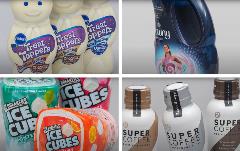Séamus Lafferty, Ph.D., is the President of Accraply. The following content is an excerpt from his keynote presentation, which was given at the AWAVirtual™ International Sleeve Label Conference on November 16, 2020.
 Today’s market is innately aware of the value that shrink sleeve labels can deliver on retail shelves. They have long-held the distinction of being the fastest growing segment of the label market - a trend that is projected to continue. We are in an era when shrink sleeves cover the gamut from the longest of long runs, like the Guinness bottle label, to the shortest of short runs, like craft beer can labels.
Today’s market is innately aware of the value that shrink sleeve labels can deliver on retail shelves. They have long-held the distinction of being the fastest growing segment of the label market - a trend that is projected to continue. We are in an era when shrink sleeves cover the gamut from the longest of long runs, like the Guinness bottle label, to the shortest of short runs, like craft beer can labels.
While it is easy to be optimistic about the continued growth of shrink sleeves, we should not be naïve. Shrink sleeves face several challenges in today's changing world. The shrink sleeve label segment must adapt and innovate if it is to continue its growth trajectory. Here are four challenges currently facing the global shrink sleeve market:
1) Growing Sustainability & Environmental Concerns
The war on plastics is playing out in real time and the shrink sleeve must make its way into the circular economy. As consumers, retailers and brand owners, we are all being challenged to reduce or eliminate plastic from our everyday lives. This is driving innovation in films, inks, and in methods and processes aimed at achieving full recyclability. These efforts are aimed at ensuring that the shrink sleeve label doesn't in any way hinder the recovery of PET in recycling streams.
2) Competitive Technologies are On the Rise
In particular, there are two competitive technologies on the rise that challenge the status of the shrink sleeve label. The first is direct-to-container printing, which can legitimately claim sustainability advantages by eliminating the need for a label in any form. It also offers a unique level of flexibility, enabling individualized and personalized packaging.
The second is stand up pouches, which eliminate the need for a label and the rigid plastic container. Pouches use anywhere from 40-70% less plastic than rigid-container-and label combinations. Because they are lighter and offer effective use of space before and after being filled, they also represent huge savings on transportation and warehousing costs. While it’s not difficult to understand their rapid growth but stand up pouches are not without drawbacks.
Despite that they use considerably less plastic, the plastic that is used in pouches is generally not recyclable. There is a legitimate debate to be had between which is better – a fully recyclable rigid container and film combination, or a standup pouch that uses less plastic but isn’t recyclable.
3) e-Commerce
Even before the global pandemic kicked online shopping into high gear, e-Commerce was a megatrend. According to Business Insider, e-Commerce in the U.S. grew 15% in 2019 and will grow 18% in 2020. So how does the switch to online shopping impact the shrink sleeve label?
At its most fundamental, the shrink sleeve’s success was driven by its effectiveness at grabbing the attention of shoppers walking the aisles of supermarkets. It’s only fair to suggest that the role of the shrink sleeve in the world of virtual shopping remains in question. While there is research that indicates that how a product is packaged is actually more important in an e-Commerce world it’s logical that, at a minimum, the point at which the shrink sleeve has its biggest impact may shift from the point of purchase to the point of unboxing on your kitchen table.
4) Quality Issues
Last but by no means least, we still find examples of the same quality issues we were seeing in this market 15+ years ago. The experience of judging the annual AWA Awards reinforces the extent to which this is real. On one hand, the judges see examples of the most superb shrink sleeves, on the other hand, we see examples of seaming issues, pre-press and distortion issues, fold lines, and application and shrinking problems.
Even though six decades have passed since the shrink sleeve was invented in Japan, it is still evolving, developing, and challenging us as though it were new. The level of innovation that is emerging across every level of the value chain hints that the growth of shrink sleeve labels it has not yet peaked.
For more information on the state of the global shrink sleeve market, watch Seamus’ full keynote presentation.
 About Séamus Lafferty, Ph.D.
About Séamus Lafferty, Ph.D.
In 2014, Séamus was named President of Accraply after joining the Barry-Wehmiller business in 2007. He brings 20+ years of shrink sleeve label production experience to Accraply and BW Packaging Systems. An academic by training, Séamus holds advanced degrees in economics, finance and economic-geography.